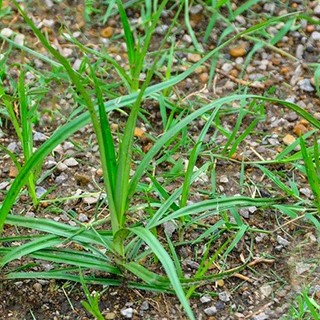This week, a question about one of the harder weeds to eliminate from the yard.
Q: I have a weed growing in my flowerbeds that’s just awful. It looks like a grass, but it’s got a triangular stem and when I pull it (it comes out easily), ten days later I have twice as many as I did before. This is happening in a bed I water generously. What is it, and how do I get rid of it?
A: If it looks like the photo here, you’re dealing with nutsedge. Nutsedge can pop up anywhere in North Texas, and it tends to be worse anywhere there’s extra moisture. Reduce unneeded extra watering as you can. Nutsedge is a tough weed to get entirely rid of. Here’s how to go about it.

Nutsedge is a sedge, not a grass. Glyphosates like Killzall and the older formulation of Roundup won’t work – they’ll burn the tops of the weed down, and every reproductive nutlet the plant has attached to its root system will promptly sprout up. We use a specific herbicide by choice called Sedgehammer to kill this weed, but you must use it properly.
Around established, woody shrubs – You can apply Sedgehammer around established woody shrubs without much issue. Don’t overspray the shrub’s foliage. You can clean up large chunks of the flowerbed in this way if you’re careful.
In established beds of ground cover – This is a toughie. Carefully spot spray, but Sedgehammer is in no way labeled for over-the-top use like this. It will likely cause damage. It almost doesn’t matter – if you don’t eradicate the nutsedge now, it’ll only get harder to do so in time. Spot spray as you can. As a note – in well established areas of liriope, we’ll often dig the liriope up entirely, carefully rinse off and separate good clumps of liriope without any nutsedge whatsoever and replant them after getting rid of the nutsedge.
In and among flowers – Sedgehammer can damage most flowers. Spot spray around when possible. Around established, woody perennials, you’re likely to get away with it.
Digging up whole chunks of soil – You aren’t going to succeed in hand weeding this one out, unless you weed the bed every day for a month and never miss a single spot. But if nothing else works, dig out whole chunks of the bed to the depth of eight to twelve inches, and refresh with weed free soil. Not practical for larger areas.
If none of the answers seems like an elegant, simple fix, it’s because there isn’t one. But with persistence, a manageable amount of collateral damage, and sweat, you can get this problem under control.
